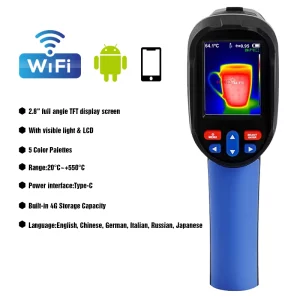In today’s world, technology has revolutionized the way we perceive and interact with the world around us. One such technological marvel that has gained significant attention is the infrared thermal imaging camera. This advaIn today’s world, technology has revolutionized the way we perceive and interact with the world around us. One such technological marvel that has gained significant attention is the infrared thermal imaging camera. nced device has found applications in various fields, from industrial to medical, and has proven to be an invaluable tool for capturing and interpreting thermal data. In this article, we will delve into What is a thermal imaging camera? how does it work?
An infrared thermal imaging camera, also known as a thermographic camera, is a device that captures the infrared radiation emitted by objects and converts it into a visible image. Unlike traditional cameras that rely on visible light to create images, thermal imaging cameras operate in the infrared spectrum, allowing them to detect and visualize heat signatures. This unique capability makes them indispensable for a wide range of applications, including building inspections, electrical maintenance, firefighting, and medical diagnostics.

The captured thermal image is then displayed on the camera’s screen, with different colors representing varying temperatures. Typically, warmer areas are displayed in warmer colors such as red, orange, or yellow, while cooler areas appear in cooler colors such as blue or green. This color-coded representation allows users to quickly identify temperature differentials and anomalies, making it easier to pinpoint potential issues or areas of interest.
Infrared thermal imaging cameras have become indispensable tools in the field of building inspections and energy audits. By detecting variations in surface temperatures, these cameras can identify areas of heat loss, moisture intrusion, and insulation deficiencies in buildings. This capability not only helps in diagnosing potential energy inefficiencies but also aids in preventive maintenance, ultimately leading to cost savings and improved energy conservation.
In the realm of electrical maintenance, infrared thermal imaging cameras play a critical role in identifying overheating components in electrical systems. By detecting abnormal temperature patterns, these cameras can pinpoint faulty connections, overloaded circuits, and damaged components, thus preventing potential electrical hazards and equipment failures. This proactive approach to maintenance has proven to be instrumental in ensuring the safety and reliability of electrical systems in various industries.
Furthermore, infrared thermal imaging cameras have found extensive use in firefighting and search and rescue operations. By visualizing heat signatures, these cameras enable firefighters to locate individuals in smoke-filled environments or identify hotspots within burning structures. This capability enhances situational awareness and aids in making informed decisions, ultimately contributing to more effective firefighting efforts and improved safety for both responders and civilians.
In the medical field, infrared thermal imaging cameras have emerged as valuable diagnostic tools for detecting abnormalities in the human body. Known as thermography, this non-invasive imaging technique can detect variations in skin surface temperatures, which may indicate underlying health conditions such as inflammation, circulatory issues, or even certain types of cancers. With its ability to provide early indications of potential health concerns, thermal imaging has become an important adjunct to traditional diagnostic methods, offering a radiation-free and painless alternative for patients.
In conclusion, the advent of infrared thermal imaging cameras has ushered in a new era of technological innovation, offering unprecedented capabilities for capturing and interpreting thermal data. As technology continues to advance, the potential applications of infrared thermal imaging cameras are bound to expand, further solidifying their status as indispensable tools for the modern world.
